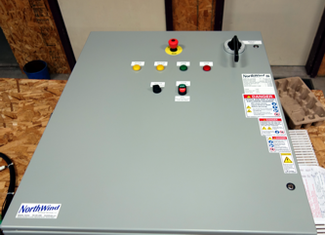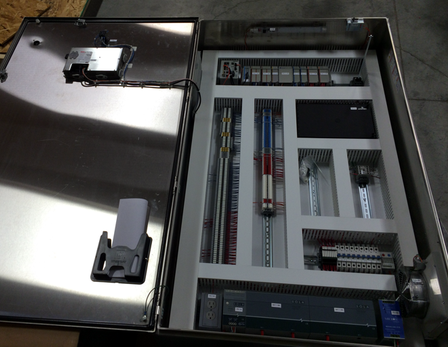Those of us that are familiar with controls systems have seen some of the benefits that can be gained when using a human machine interface (HMI) vs using a simple pushbutton control panel. Some of the main benefits an HMI provides include increased efficiency, safety, and overall functionality. While a pushbutton panel is easily understood and simple, it can be severely limited in the level of complexity of the systems it can handle. Another limitation is that the efficiency of a pushbutton panel depends solely on the experience of the operator.
Pushbutton Control Panels
 Plants have been running for ages using pushbutton equipment control. This method is well understood by the people who operate these systems and their efficiency is directly tied to the experience, proficiency and focus of the operator. Because pushbuttons are simple, it is sometimes an inexpensive solution for use in small systems. Ideally, a pushbutton panel is used on a simple system with just a few pieces of equipment. For example, it may be easier to understand and functionally adequate to run a small vacuum and receiver system by simply using a “start/stop” button.
Plants have been running for ages using pushbutton equipment control. This method is well understood by the people who operate these systems and their efficiency is directly tied to the experience, proficiency and focus of the operator. Because pushbuttons are simple, it is sometimes an inexpensive solution for use in small systems. Ideally, a pushbutton panel is used on a simple system with just a few pieces of equipment. For example, it may be easier to understand and functionally adequate to run a small vacuum and receiver system by simply using a “start/stop” button.
Pushbutton panels begin to exhibit shortcomings when the system grows to more than just a few pieces of equipment. With multiple machines in operation, it is not always clear which machine is running at any given time and this can make diagnosing issues a nightmare. Another shortcoming of pushbutton panels is that it is hard for new workers to learn how different operating systems interact with others on the plant floor. This can lead to increased training time and lower production as a trainee is learning to use the system. Further limitations of pushbutton panels come in the area of documentation. Because there is no display available on the panel, it is often necessary to go to each piece of equipment in the plant to document weights, flow rates, etc. Also, in order to troubleshoot a pushbutton panel, the panel door must be opened. This can lead to safety hazards with live voltage or difficulties troubleshooting if the panel is powered off.
HMI Control Panels
 As factory processes and control systems grow more complex, it is apparent that having a graphical display on control panels becomes the best solution in almost all cases. Also, systems that need to communicate with each other, such as an extruder/dryer system, require a display in order to run efficiently. In most cases, an entire system with multiple pieces of equipment can be run from one well integrated HMI display.
As factory processes and control systems grow more complex, it is apparent that having a graphical display on control panels becomes the best solution in almost all cases. Also, systems that need to communicate with each other, such as an extruder/dryer system, require a display in order to run efficiently. In most cases, an entire system with multiple pieces of equipment can be run from one well integrated HMI display.
Maximizing production and testing is also easier using HMI’s because many values can be altered through the display. It is possible to set the display to show all of the data a user may need to document including production levels and efficiencies. Lot tracking, weights, flow rates, and trending information are some of the more common types of information that are documented with an HMI. The HMI can also be designed to include faults and warnings in order to more easily troubleshoot problems. In fact, the capabilities of HMI panels can exceed the actual needs of a system.
The program file for an HMI display can be developed concurrently with the project electrical installation. This can lead to reduced lead times since the file can be installed during the system start-up phase. With large and complicated systems, wiring for an HMI panel can also be a much cleaner and safer affair. Since only an Ethernet cord needs to be run to the door of the HMI panel, the amount of wiring is greatly reduced compared to wiring a large number of pushbuttons that would otherwise be needed to obtain similar functionality.
Some of the shortcomings of an HMI are higher cost and potential deterioration in abusive environments. For systems where harsh chemicals are used or other inhospitable conditions exist, the more rugged pushbutton option may be recommended. A way to circumvent this is to use a pushbutton panel in the abusive area linked with an HMI panel located in a more accommodating environment. While most HMI’s are fairly sturdy, the display screens may not be able to stand up to prolonged abuse. And while HMI panels offer increased functionality, they simply may not be cost effective for very small systems.
Retrofitting Pushbutton Systems
It is almost always better to decide at the beginning of a project (during the design phase) to use an HMI rather than to add one in later. However, it is possible to retrofit an older pushbutton panel with a display in order to gain the advantages of an HMI. When changing from a pushbutton to an HMI panel, physical copies of drawing packages can be condensed into the program file on the display. This allows the user to easily find I/O and tag information that is otherwise difficult to find. In addition, while drawing sets can be lost or damaged during normal production, the program file in an HMI provides a more stable platform to store information.
Since an HMI display often reduces the required size of the panel, it is usually unnecessary to purchase a new panel. A retrofit may simply require that a new door be ordered to eliminate the holes left by buttons and accommodate the HMI display screen.
Summary
In summary, the main benefit to using a pushbutton panel comes in the form of simplicity and cost savings, especially for small, simple processes. However, this is generally only true on systems that can be run with fewer than 8-10 buttons. While an HMI can be more expensive to implement, it is possible to manage much larger systems through the use of a screen. In addition, documentation and information availability is much greater and easier with a system display. An HMI display can also provide greater safety than pushbutton panels. The decision about which type of control panel will be right for a project should therefore be based on the size of the system to be controlled, how much functionality the system will require and the project budget.

